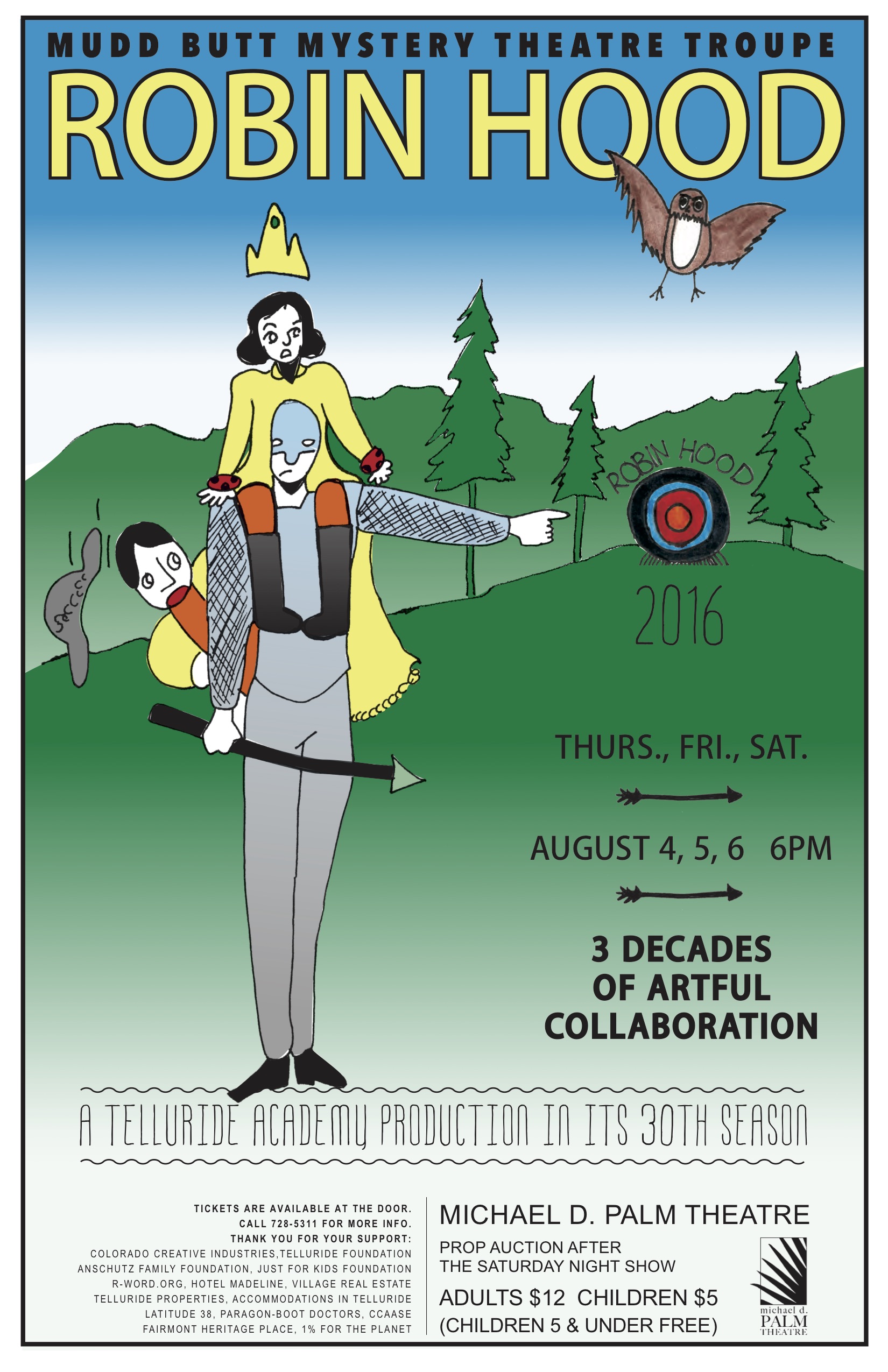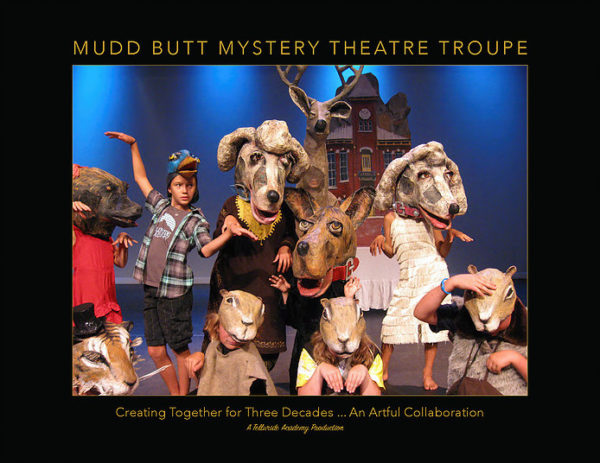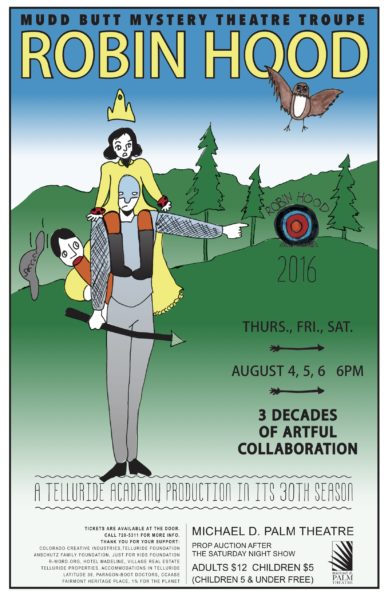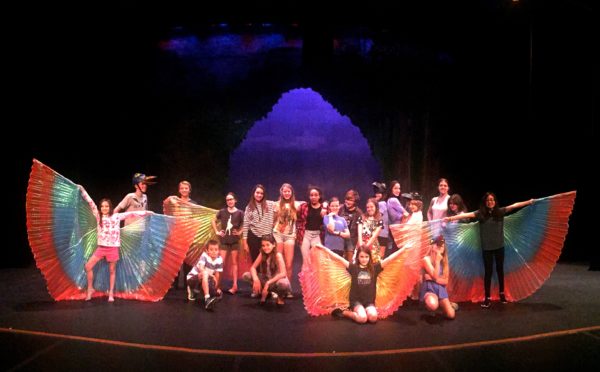
29 Jul Mudd Butts Celebrate 30 Years: “Robin Hood”
The 30th annual production of the Telluride Academy’s collaborative theater adventure known as the Mudd Butts Mystery Theatre Troupe takes place Thursday, August 4 – Saturday, August 6, 6 p.m., at Telluride’s Palm Theatre. As always, the final show on Saturday is followed by an auction featuring Mike Stasiuk’s fabulous creations (masks, props, etc.). This year the production is based on the legend of Robin Hood. Tickets are $12 for adults; $5 for kids; free for children under 5. Available only at the door. To celebrate 30 years of Mudd Butts and support 30 more years, the Telluride Academy is offering the 30th Anniversary Commemorative Book, 195 pages of photographs, stories, mysteries, and memories. To purchase, email Academy director Elaine Demas at elaine@tellurideacademy.org. To donate to the Mudd Butts and other Academy programs, go here.

Why Robin Hood:
Hope springs eternal – as do plot lines for 30 years of Mudd Butts productions. Yes, 30 years and counting.
“Don Quixote.”
“Fatima the Spinner.”
“1001 Arabian Night.”
“The Odyssey of Homer”
“Fears of Your Life.”
All inspired and inspiring past Mudd Butts productions.
But inspired by what? Whatever is blowing in the wind?
In the case of “Robin Hood,” what was blowing in the wind, plus local and national headlines and global challenges – and defiance, rather ‘Defiance,” the movie.
“Definance” (2008) tells the story of Jewish brothers in Nazi-occupied Eastern Europe who escape into the Belarussian forests. There they join Russian resistance fighters and endeavor to build a village to protect themselves and about 1,200 Jewish non-combatants.
The director was Ed Zwick; the screenwriter was Clayton Frohman. Clay also works (has for about 12 years) with Mudd Butts’ dynamic duo, Sally Davis and Kim Epifano, cranking out magical scripts for the annual drama camp’s production.
A group of people hiding in a forest. A self-contained community, who survived, governed themselves, faced ethical questions, sorted out leadership and support roles, fed themselves by stealing food, even established a hospital, a court, and a tannery. The story also includes a clash between two brothers (Liev Schreiber and Daniel Craig. Cain and Abel – or Richard the Lionhearted and Prince John?) And there was romance.
“‘Defiance’ reminded me of all the symbolism of the forest. All the elements of the film, all the bread crumbs, led me to Robin Hood,” explains Clay.

Forests have traditionally had a strong association with the unconsciousness and served as places for the fairy tales and romance legends of the world such as “King Arthur and the Knights of the Round Table,” Grimm brothers, “Hansel & Gretel” and so much more. Forests are places of mystery, of dangers and demons, enemies and disease. Young people must contend with all the forces of the forest writ large to transition into adulthood.
Forests have special magic powers, so magical people live in them: Snow White, Goldilocks – and Robin Hood.
“Robin Hood is a timely tale and many parts of the story have remained true over the centuries. Robin is an old story, but everyone knows its outlines. The legend is both serious and comical. And Robin Hood himself is refreshing because he is an outlaw hero fighting for downtrodden people,” says Sally.
“It feels meaningful to take on the story of Robin Hood because there is still a complete divide between the rich and the poor, the 1% percent versus the 99%. Kids can relate to the story’s heroes and heroines and use the characters as vehicles to express their feelings and thoughts about the world. Robin Hood is also nice because it can be a gender neutral role,” adds Kim. “And with Sherwood Forest as the primary setting, talking about the environmental challenges facing the planet is a natural: our script incorporates a love of nature and the need to protect and preserve Mother Nature.”
“Beyond the story of income inequality and the environment, Robin Hood is also a tale of adventure, passion, and heroism. It is a great kids’ story in which the setting, Nottingham, England, can be used as a platform to study the politics of today,” concludes Sally.
Robin Hood, a short version of a never-ending story:

Guest artist Ashley Boling and two members of the cast.
In the 13th century,the time of Henry III, a certain Robert Hod, later called Hobbehod, was a tenant of the Archbishop of York. But no one can know for sure whether the legend of Robin Hood is based on his character.
“The Merry Adventures of of Great Renown in Nottinghamshire” is an 1883 written novel by American illustrator and author Howard Pyle. In it, Pyle depicted Robin as an heroic outlaw and highly skilled archer and swordsman.
In truth, the legend of Robin Hood has been going strong for over 600 years.
Over time, Robin came to be known as a yeoman, a knight, and an earl. He was described as a courteous robber, a brigand and brawler, a medieval revolutionary, and the servant of a Pagan god, even a woman in man’s clothing.
Robin Hood became the grist of movies, including several Disney films; a 1976 version featuring Sean Connery and Audrey Hepburn; “Prince of Thieves, starring Kevin Costner; a Mel Brooks parody, “Men in Tights”; even a 3D German fantasy depicting the character as an undead menace (“Robin: Ghosts of Sherwood”).
According to boldoutlaw.com, “THE classic Robin Hood is Errol Flynn in Warner Bros., 1938 “The Adventures of Robin Hood” in which Robin and his Merry Men famously wear tights. Parts are anachronistic and unhistorical (there’s a car in one shot). But it’s also fun — lots of fun. Errol Flynn is extremely charismatic as the roguish Saxon freedom fighter. There are a lot of witty exchanges such as when Marian expresses shock at Robin’s insults of Prince John. “Why, you speak treason.” “Fluently,” Robin replies…”
TV shows inspired by the legend include the 1950s series “The Adventures of Robin Hood” and a 1980s version, “Robin of Sherwood,” in which Robin Hood is Robin of Loxley, a young peasant and servant (“son”) of the Celtic horned god, Herne the Hunter.
Robin is the muse who has inspired many sci-fi and fantasy novels and video games.
The classic story line follows Robin Hood as he becomes an outlaw after a conflict with foresters and through his many adventures and run-ins with the law, usually dressed in Lincoln green, and “robbing from the rich and giving to the poor.” Stories of Little John defeating Robin in a fight with staffs, of Robin’s besting at the hands of Friar Tuck, and of his collusion with Allan-a-Dale are all part of the myth.
Most versions, however, feature a Hollywood ending: Robin and his men are pardoned by King Richard the Lionheart and his band is incorporated into the king’s retinue, much to the dismay of the wicked Sheriff of Nottingham.
And the Mudd Butts’ spin? Again, the 30th annual Mudd Butts production is based on the legend of Robin Hood – but which version?: classic? Mel Brooks?, Monty Python?, Loxley?, all of the above? Show time is Thursday, August 4 – Saturday, August 6, 6 p.m.
Robin Hood, Mudd Butts’ 2016 cast list:

Claire Aguilar
Haley Brackett
Audrey Garner
Lilly Harrison
Soren Hughes
Sierra Lavine
Grace Minarovic
Kenneth Penman
Chloie Plumber
Zoe Rehnborg
Reese Sherar
Brooke Shifrin
Sadie Steinberg
Emmie Strang
Ruby Tanguay
Koko Waller
Kiara Warren
Rowen Warren
Sofia Werner
Sarah Yates
Annika Zinn
“This year the Goddess gifted us with young performers who want to dig in and eat up whatever we give them. They are hungry to be on stage,” says Sally and Kim.

Emmie becomes a Mudd Butt after a slide down Cornet Creek, the annual ritual and source of the name of the drama troupe.
In the mid-1980s, a woman named Margaret Hatcher was recruited from the Houston Magnet School for the Arts to become the new superintendent of the Telluride Schools. Though Margaret had a real passion for arts education, all she inherited were crayons and easels, an old boom box, and a number of broken instruments collecting dust under a stage.
Margaret then did a very smart thing: she hired local educator Wendy Brooks to begin a series of enrichment programs for the students in the district, the offshoot of which was called The Telluride Academy.
The Telluride Academy was to be a tuition-based adjunct to the school, sharing facilities and filling in gaps in a very small district (at the time, 172 students, K-12). Its budget did not allow for adequate courses in history, language, and the arts.
In a light bulb moment Wendy realized she had stumbled into her dream job: she could create programming in a variety of genres to fill those critical gaps.
In 1987, Wendy recruited two young friends-of-a-friend, thespians from San Francisco – theater director, performance artist, and arts educator Sally Davis, and award-winning choreographer, director, performer, vocalist, and educator Kim Eipifano. Sally and Kim arrived ready and willing to work with seven girl students to create theater in the schools. They called their program the “Mystery Theater” camp. More help arrived on the scene: artists John Fago and Pamela Lifton Zoline. In 1990, a brilliant sculptor, perfectly suited to the task that became his Telluride universe, came from Portsmouth, New Hampshire: propmeister extraordinaire Michael Stasiuk was on board.
Over the years, the core group brought in numerous guest artists from around the globe – like Clay Frohman, also Sally and Kim’s partners, Bart Hopkin and Richard Kittle. Mudd Butts is always blessed with the return of some of their graduates, who also roll up their sleeves to help. Collectively everyone in the Mudd Butts universe is nothing if not outspoken and smart; everything discussed, generally topical and on point.
Today, the Mystery Drama Troupe, or Mudd Butts, remains the oldest continuous class offered by the Telluride Academy. There were years when kids had be chosen from an over-large pool of prospects all wanting to be one of the Fabulous 25.
“All these seasons down the road, the program still fills up and still delivers,” says Wendy with evident pride.
The Telluride Academy’s Mudd Butts is a four-week theater intensive covering all aspects of what it takes to make a play happen. Through the Mudd Butts, kids aged 10 – 13, get to explore theater games, script and songwriting, improvisation, dance, voice, even marketing. But that’s only what’s described in the Academy’s brochure.
Read between the lines and it becomes clear the young people fortunate enough to participate in the Mudd Butts wind up acquiring invaluable and indelible life tools. Kids meet their inner artist while developing confidence and discovering ways to laugh at themselves and navigate the mind field of group dynamics. What the directors are after to broadening kids’ horizons about social, political and environmental issues. Through the Mudd Butts experience, kids travel from a local address on to the world stage. (Literally at times. Wendy went on to create ia Mudd Butts International program in 1993. See more on that below.)
“In a show of utter devotion, love, care, and endurance, Sally and Kim have shown up every single year, growing up and older with the program and refining the details to its current, wondrous state,” continues Wendy. “When the show goes up this year, 35-year-old Mudd Butt graduates will be bringing THEIR children to see the production. In fact, over 500 kids have been part of one or more Mudd Butts classes, and now the first of their own children is old enough to be enrolled. Perhaps more to my personal point, my oldest grandson Julien Brooks has two years of Mudd Butts AND two years of Mutt Butts International under his belt; younger brother Philip started his career this summer with Circus Holus Bolus,” adds Wendy.
Highlights of the past 30 years?
“Every play we’ve ever done has had its highlights; every group too. It is almost impossible to choose the stand-outs because each day with Mudd Butts shines. We just love the collaborative aspect of our work: young teens creating with adult artists. Our focus is experimentation, self-exploration, and a combination of art forms. For 30 years, everyday spent together with our team, with our kids, has been a highlight,” explains Sally and Kim, who remain the heart and soul of the Mudd Butts and the troupe’s guiding angels.“We still do this after 30 years because the work transforms us all and challenges everyone of us creatively to push the envelope. Plus seeing how Telluride has changed just adds to the intrigue– and, of course, impacts the stories we tell.”
Mudd Butts International or MBI, in Wendy’s words:

Kim and Kiara
It was the sadness the original Mudd Butts felt when they aged out of the program in 1991 that led to the creation of Mudd Butts International, begun in 1993.
Graduating Butts were invited on a three-week international intensive where they would live and work with their peers in a selected second- or third- world village and create a masterpiece of art and music, meant to unite the two cultures.
Traveling the world to bring peace and understanding, laughter and a deep creative connection between students, MBI was an instant hit – and is still a hit at 22 years of age.
Academy staff still have close ties with students and teachers from Ireland, Turkey, Jordan, Ethiopia, Viet Nam, Indonesia, Bahamas, and Chile. Many students’ lives were changed by our interaction with them – and, in improbable and magical ways, our own kids’ lives were transformed as well.
MBI programs have been held in improbably places over the years: Slovakia the year after independence; Viet Nam on the 40th anniversary of the American invasion; an orphanage for Tibetan children in northern India; Haile Selassie’s summer home in western Ethiopia; central Turkey where host moms wore head scarves.
MBI has propelled kids who have been on these international adventures to do great things as adults. Several times a year, an MBI graduate will write and say: “I would never have been able to do X or Y or Z, if I hadn’t been challenged, if I hadn’t had my horizons expanded so dramatically, at such a young age.”
I know my own world view has grown and been enriched by my connection with thespians who continue to think way outside my box and have challenged me to join them. I photograph differently; I appreciate different attributes of kids; I take more risks; I sing more loudly and freely. I dare to be more like them.
Thank you for the gifts!
And let our adventures continue.


Sorry, the comment form is closed at this time.